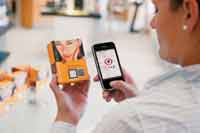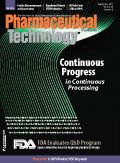Verification through Telecommunication
Smartphones could become the product-authentication tool of choice. Contains online bonus material.
Counterfeiting is becoming more sophisticated and widespread, but the number of overt and covert tools to fight it is growing. As a result, the global market for anticounterfeiting products for pharmaceuticals and foods is expected to increase to $79.3 billion by 2014, reflecting a compound annual growth rate (CAGR) of 8.6% since 2009. According to this forecast, North America will account for almost two-thirds (62%) of this expenditure; however, the second-largest market, Asia, is expected to expand faster, with a CAGR of nearly 20% because of the low penetration of anticounterfeiting measures and a significant level of counterfeiting in the region (1).

Hallie Forcinio
Interest is particularly high in protective technologies that rely on input from a smartphone. Readily available worldwide, smartphones can authenticate products in real time at the point of purchase or at home. In fact, global smartphone sales will top 420 million devices in 2011, accounting for 28% of all handsets. With the introduction of affordable "entry-level" smartphones, researchers predict that annual sales will surpass 1 billion devices by the end of 2016, or one of every two mobile handsets sold (2).
As well as being increasingly likely to own a smartphone, consumers also find the device familiar and easy to use. Smartphone authentication technology delivers an immediate "authentic" or "not authentic" response to a text or to the scan of a barcode or other package feature. Frequently, the authentication technology also can send product-related information, support track-and-trace or pedigree initiatives, or collect data about the purchase. Therefore, smartphone-based technology "is finding favor as an alternative to 'specialist' readers across the entire authentication market," wrote William Llewellyn, vice-president and senior consultant at AWA Alexander Watson Associates, a Netherlands-based market-research firm (3).
Smartphone-based authentication technology is already in use in Nigeria and has been so successful that it will be commercialized in other countries in Africa, as well as in India. "Given the prevalence of mobile technology throughout the world, it made sense to use a technology that was already in every customer's pocket," explains Ashifi Gogo, cofounder and chief executive officer of Sproxil, a provider of brand-protection software and services.
In Nigeria, consumers remove a scratch-off overprint, similar to that used for lottery tickets, to reveal a one-time-use code. Then they text it to a phone number that works on all cellular networks within the country, and servers dispatch a response indicating whether the drug is genuine. Confirmation messages also can be customized to include information, such as disease-management tips. Both outgoing and incoming text messages are free. If a fake product is found, the consumer is given a hotline number to call. Hotline personnel report fake products to the Nigerian Agency for Food, Drug, and Administrative Control for further investigation (Mobile Product Authentication analytics, scratch-off labels, Sproxil).
A similar technology has been adopted by Unichem Laboratories to simplify the authentication of products made at two of its plants in India. Blister lidstock is printed with a unique barcode and private virtual phone number. Implementation on the packaging line simply requires a printer to apply the barcode and a scanner at the end of the line to record it. Because the barcode-generating and -authenticating software is compatible with most printers, it's possible to use existing units.

A Smartphone doesn't have to be connected to the network to authenticate a product with a 1-Tag label from Heidelberg.
To authenticate a product, the consumer dials the phone number and texts the code. Response is immediate and can include targeted information, and the interactive connection makes it possible to collect unit-level sales data, including geographic location, time to market, and drug-authentication history. The system also can send reminders to take a dose, refill a prescription, or follow up with a doctor (Unique ID Mobile Verification, PharmaSecure).
Another smartphone-based product-authentication method relies on a custom two-dimensional (2D) code printed with visible or invisible ink. Scanning the code links the user to a web portal that confirms whether the product is authentic, as well as delivering other information, such as coupons, product videos, directions for use, or recall updates. The code also can be used during the packaging process to prevent label or product mixups, verify that kit components are correct and complete, and support track-and-trace initiatives. Like other smartphone-based authentication methods, the interactive, multilingual system allows manufacturers to communicate directly with consumers and collect demographic information (Mi6 2D code and DigiTrack system, Complete Inspection Systems).
A similar closed-loop system securely generates a unique alphanumeric code for each item so consumers can verify its authenticity by texting it or typing it in on a website. A consumer registering a code for the first time will receive confirmation by a return text message, but if the code has already been registered or is not recorded in the database, an instant text message delivers a warning. The manufacturer also can send product or promotional information, reminders to take a dose, or alerts about product changes. As well as being suitable for use wherever cell service is available, the multilingual system automatically adjusts the language and message content according to the message received (Pro-tex, Chesapeake).
Not all smartphone-based product authentication methods rely on alphanumeric codes or barcodes. Another option involves printing or molding microdots on a product or package, capturing an image of the random pattern, and then storing it in a database. When it's time to authenticate the product, the consumer scans the pattern with his or her smartphone, transmits the image, and receives confirmation seconds later (Cryptoglyph pattern, Fingerprint technology, and remote verification processes, AlpVision).
The fingerprint concept also is used for a security label that combines labelstock with copper threads and a 2D barcode. A free mobile software application specifically developed for this technology enables end users to confirm authenticity without a network connection. As a result, authentication can be done for free anywhere in the world.
The random pattern formed by the copper threads is read by a camera, and a cryptographic key unique to each manufacturer converts it into a unique code. This code is then printed on the label next to the thread pattern using a digital drop-on-demand inkjet system. Cryptographic signature technology links the random pattern, code, and product information so they cannot be separated (1-Tag system and labelstock, Linoprint inkjet printer, Heidelberger Druckmaschinen).
When the label is scanned to confirm authenticity, the software immediately detects whether the content of the code matches the pattern of the neighboring copper threads. The application also displays the corresponding brand, the product name, and the size of the packaging. It can supply additional product-specific information as well. For example, the expiration date or batch number can be integrated into the code and accessed in parallel to the authenticity check. If desired, weblinks also can be delivered to give consumers access to product or manufacturer websites.
A quota system prevents misuse and simplifies label reconciliation counts by specifying in advance how many items can be labeled at a time and what product information can be encoded. The quota is specified through a secure Internet connection and can be redefined quickly and easily each day.
Covert protection
Other anticounterfeiting methods currently capturing attention incorporate tiny identifiers into the package, label, or the product itself. Some of these covert tools rely on smartphone scanning, while others require devices such as portable magnifiers.
One nanotechnology-based covert solution randomly distributes micro- and nanoparticles in a material to create machine-readable fingerprints. A proprietary, handheld scanning device scans the fingerprint and instantly communicates the encrypted information to a secure server through mobility platforms such as GPRS, 3G, or Broadband, which returns a complete authentication report to a cell phone or computer (nonClonableID, Bilcare Technologies).
A pill-level solution blends microtags into immediate-release film coatings for solid dosage forms. The customized microtags can hold significant amounts of brand-owner-specific, encrypted information, such as lot and batch numbers, logos, and other text, patterns, shapes, and symbols in a particle smaller than the diameter of a human hair. Invisible to the naked eye, the microtags are readily detectable with portable magnifiers.
The microtags consist of materials generally regarded as safe or from FDA's Inactive Ingredients Database. They have no effect on dissolution or stability and integrate seamlessly into the coating process. As a result, adding the microtags to an existing coating is considered a Level I annual reportable change under the scale-up and postapproval changes guidance. Drug manufacturers can adopt the technology without prior approval from FDA (mark On-Dose ID covert marker technology and vision Optical Viewing systems, ARmark Authentication Technologies, and coatings, Colorcon).
Michigan State University fights counterfeiting
A multidisciplinary program at Michigan State University (MSU) performs research to counter counterfeiting. MSU’s Anti-Counterfeiting and Product Protection Program (A-CAPPP) ranks as the first academic body to focus its attention on this global problem. A Counterfeit Incident Database, one of the group’s first research projects, will support much of its work developing counterstrategies. Composed of scholars of consumer behavior, packaging, criminal justice, supply-chain management, international business, forensic sciences, engineering, food safety, public health, intellectual-property-rights law, standards, and risk communication, A-CAPPP also organizes outreach activities, such as webinars and seminars. In addition, A-CAPPP publishes background papers, such as “Pharmaceutical Counterfeiting in the US: Differentiating Dimensions of Risk.”
Hallie Forcinio is Pharmaceutical Technology's Packaging Forum editor, 4708 Morningside Drive, Cleveland, OH 44109, tel. 216.351.5824, fax 216.351.5684, editorhal@cs.com.
References
1. MarketsandMarkets, Global Anti Counterfeit Market for Food and Pharmaceuticals report, (MarketsandMarkets, Dallas, TX, 2011).
2. IMS Research, Mobile Handset Market Intelligence Service & Database (IMS Research, Austin, TX, 2011)
3. W. Llewellyn, Packaging Digest (2011), www.packagingdigest.com/article/518765-New_technology_aids_fight_against_counterfeiters.php accessed Aug. 11, 2011.

Pharmaceutical Tariffs Are Imminent: How Industry is Bracing for Impact
April 16th 2025On April 14, 2025, the Trump Administration launched a national security-driven investigation into pharmaceuticals, a move that will likely result in tariffs being placed on pharmaceutical drugs, ingredients, and other components that are imported from outside of the United States.